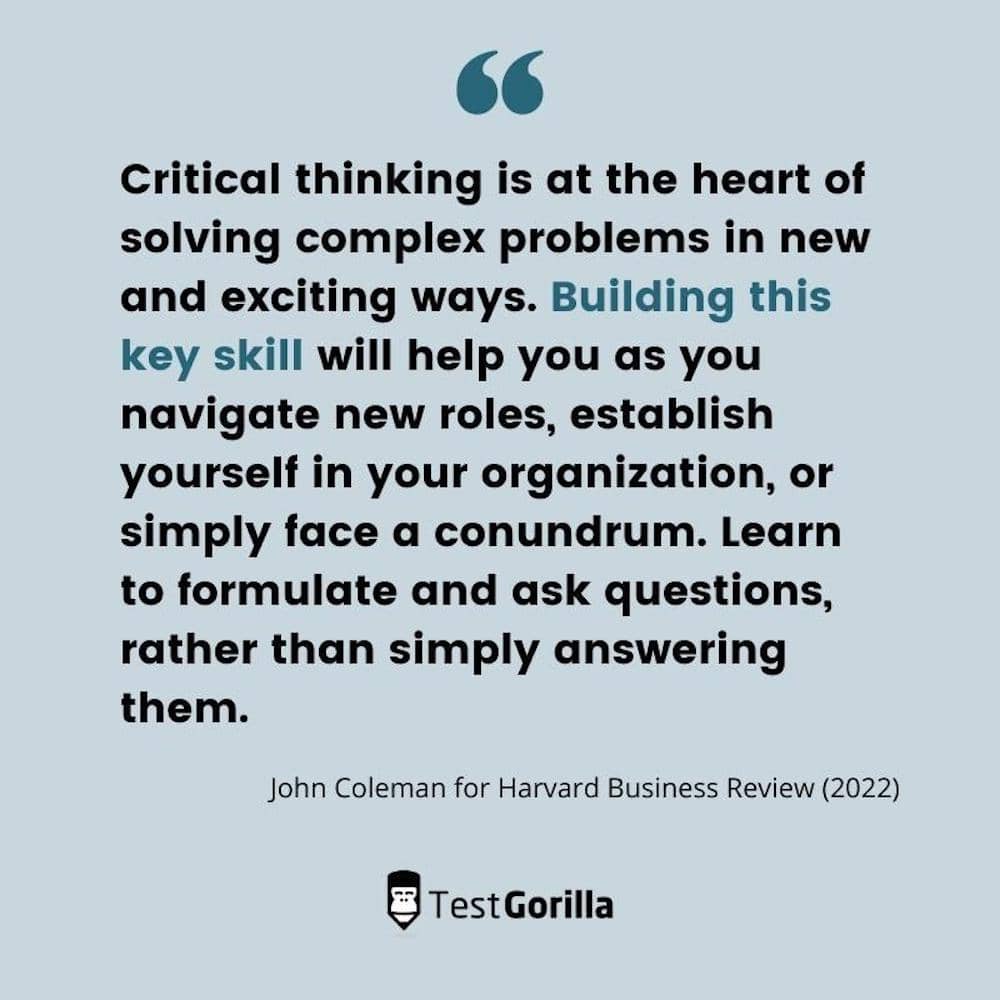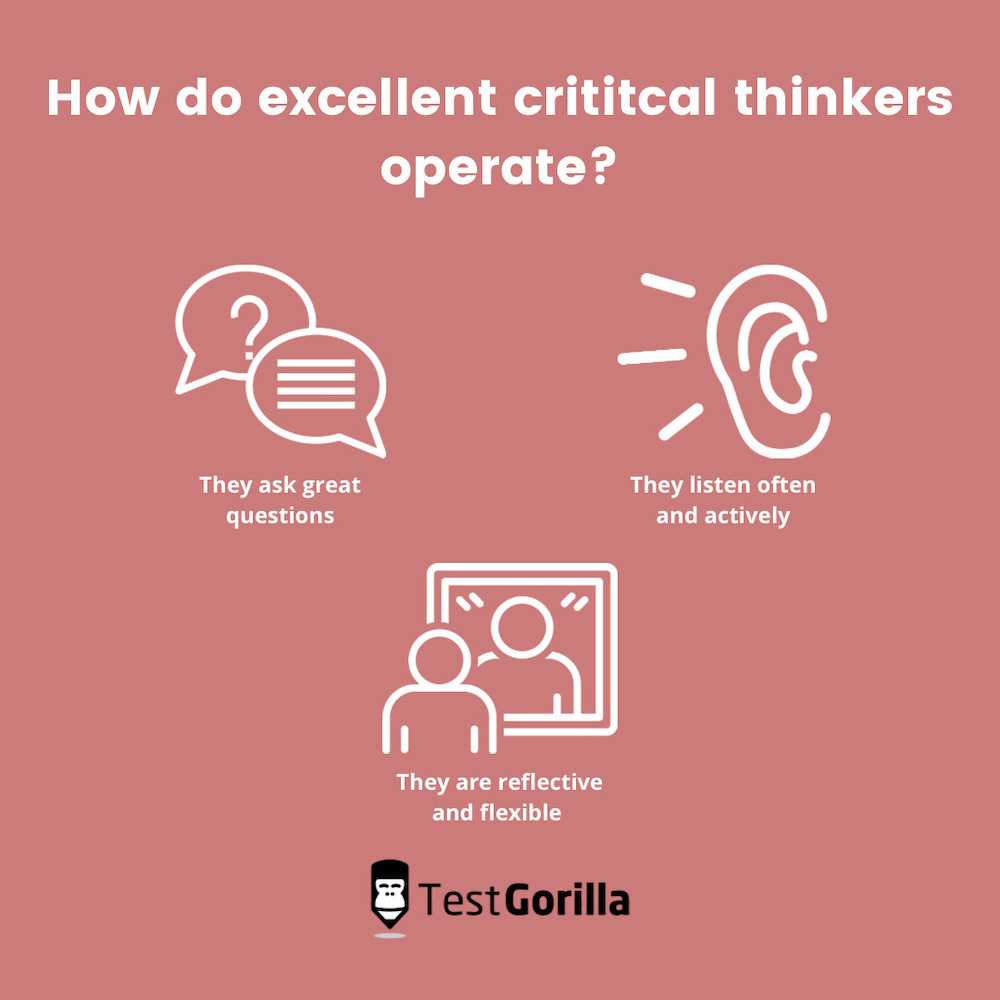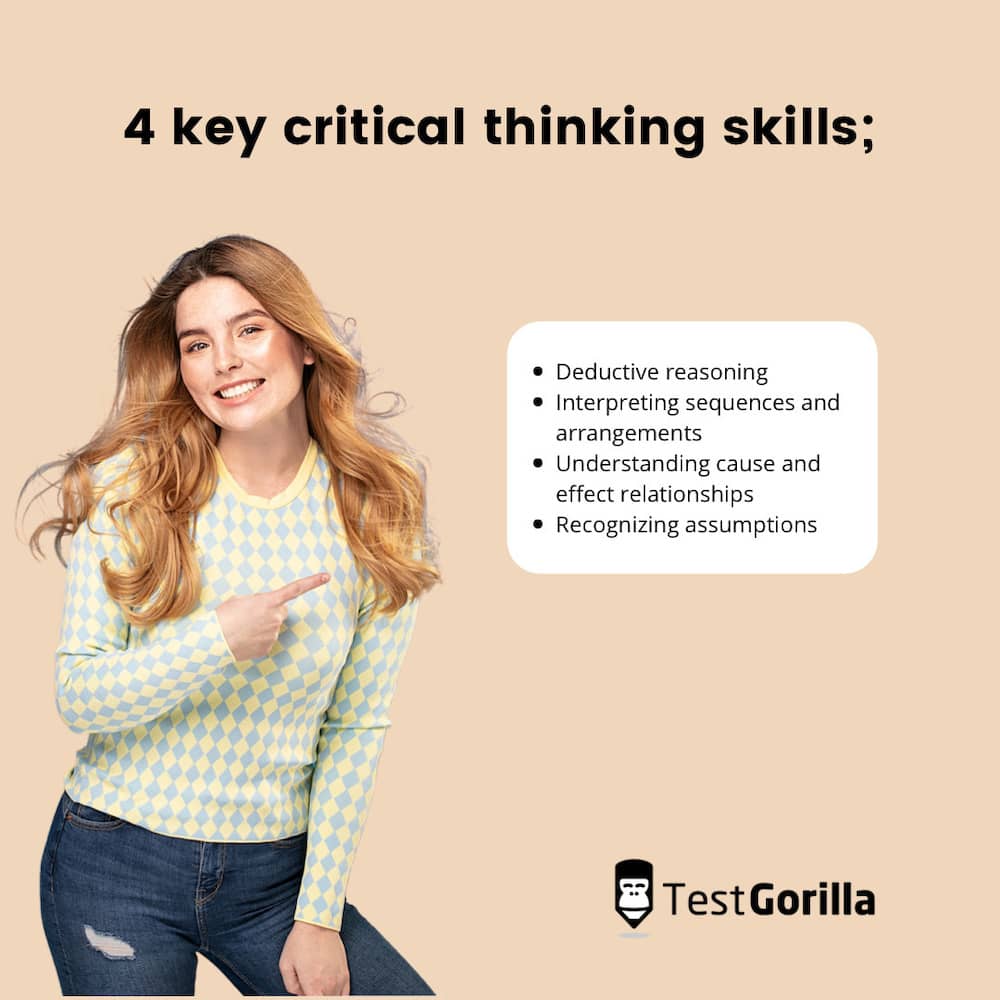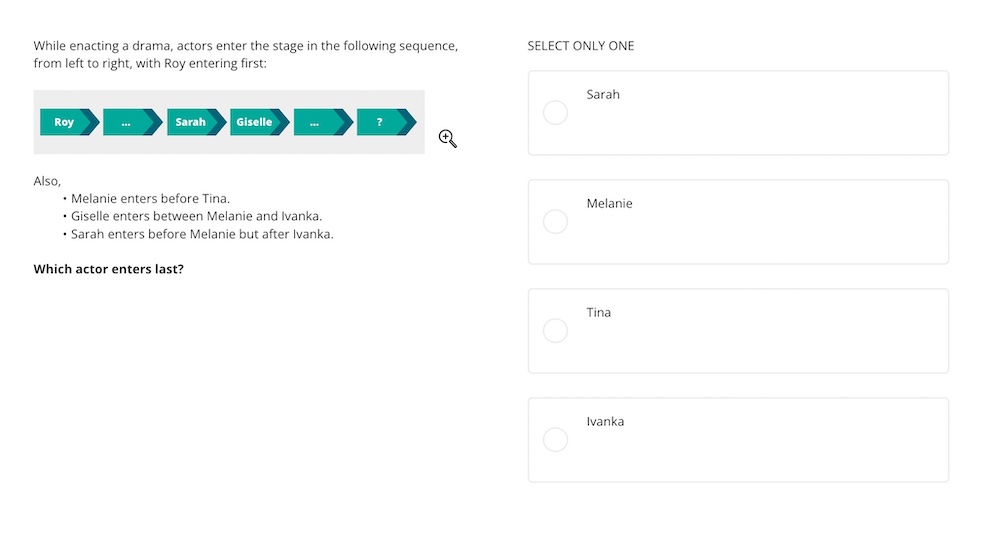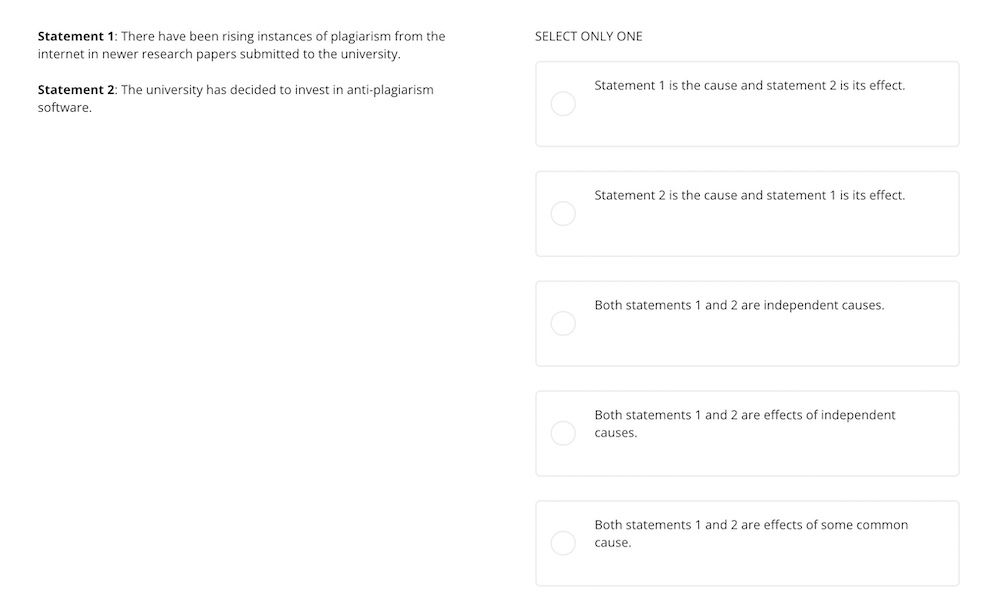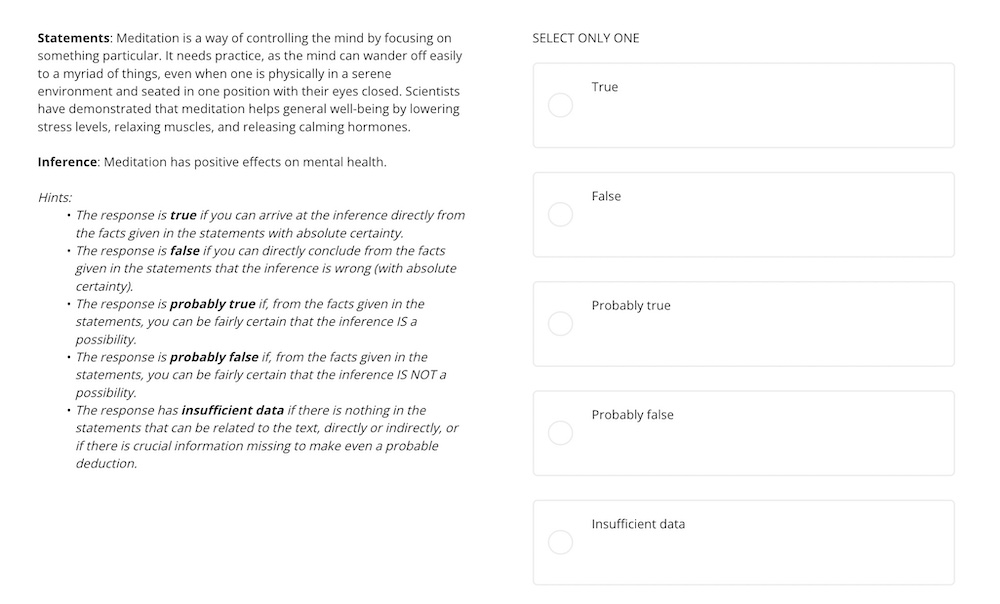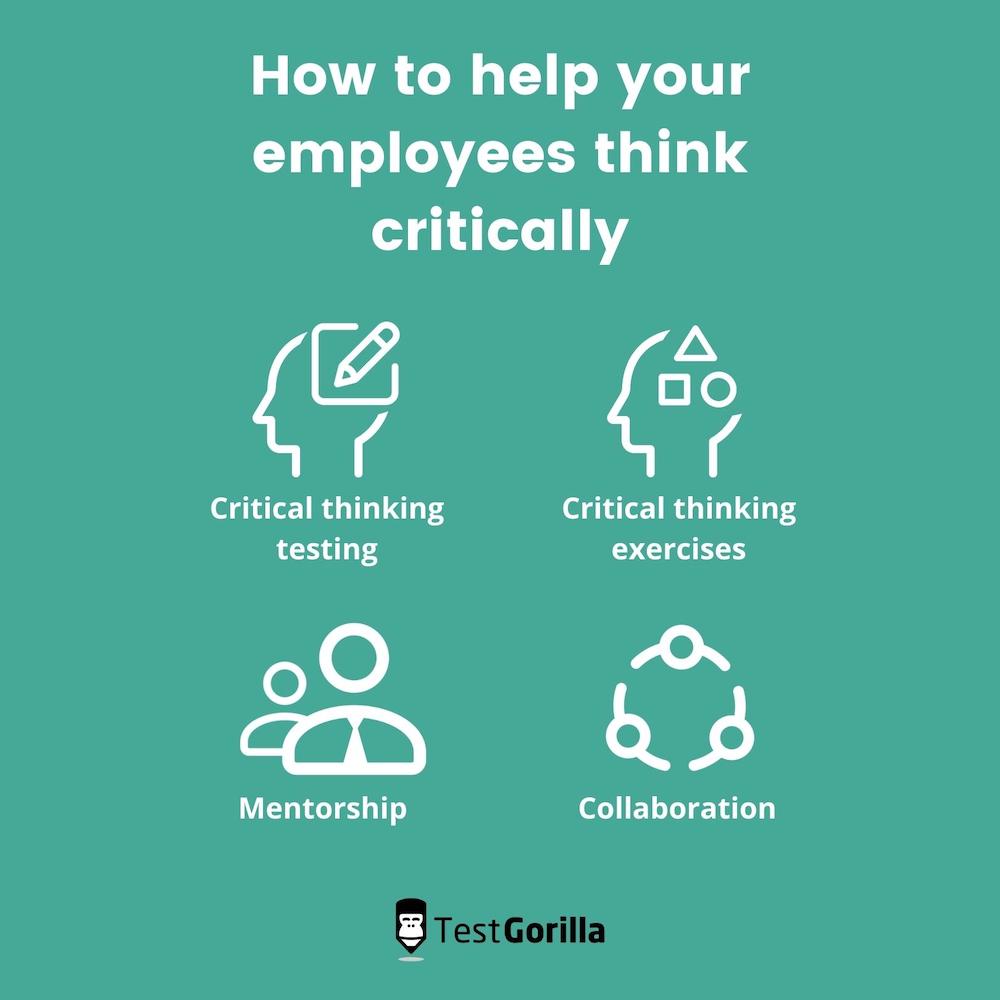Research suggests that, on average, adults make about 35,000 conscious decisions every day.
A scary number indeed, but the decisions we make daily will all vary in their own scariness. Choosing what to wear in the morning, for example, is less anxiety-inducing and requires less thought than, say, deciding where to make budget cuts in your business.
This being said, every decision triggers consequences, no matter how small. If you don’t choose a weather-appropriate outfit, you might spend your day feeling uncomfortable. And if you aren’t smart about where to make those budget cuts, you could jeopardize your company’s financial stability.
How can we ensure we’re turning as many of our 35,000 daily decisions as possible into sound ones?
This is where critical thinking comes in. Critical thinking is about effectively conceptualizing, applying, analyzing, synthesizing, and evaluating information to make judgments and formulate innovative solutions.
It involves using all of the information around you to make decisions. As a really basic example, you might check the weather forecast before choosing an outfit for the day.
Critical thinking is that mode of thinking – about any subject, content, or problem – in which the thinker improves the quality of his or her thinking by skillfully taking charge of the structures inherent in thinking and imposing intellectual standards upon them.
Critical thinking skills are vital both in the workplace and outside of it. Read on to find out more about critical thinking skills, how to test for them, and how to encourage your employees to think critically.
Table of contents
Why is critical thinking important?
Because of the kind of world we live in, critical thinking has significance beyond just ensuring you don’t leave the house without a raincoat on a wet day.
Every day we each face an onslaught of media, lots of which is biased or manipulative. In fact, 57% of Americans agree that the mainstream media is more interested in making money than telling the truth.
If we fail to consume this media critically, the consequences can be pretty bad. Critical thinking enables us to combat misinformation and bias, and make the world a more friendly and well-informed place.
Critical thinking at work
Why then, you might ask, are critical thinking skills important in the workplace? Aren’t we supposed to trust the people we work with? Are we to start questioning everything our colleagues say, or everything our managers ask us to do?
Thinking critically is not just about questioning things for the sake of it. It’s about using contextual information to scrutinize and evaluate facts and arguments. It encourages reflection, competence, and independence.
So, to answer those questions: Yes, we should trust the people we work with. But we all say and do things that bear scrutiny.
Perhaps a colleague makes a judgment and you spot a potential consequence that they haven’t considered, or maybe your boss asks you to do something but you have an idea about how to do it differently and more effectively. In both cases, you’ve thought about things critically to help your team operate more successfully, and you can communicate your observations constructively so that your team makes better decisions.
But great critical thinkers don’t just interrogate other people’s ideas. Employees who are constantly and intelligently seeking to adjust their own working strategies for the better are invaluable to any workplace. A few benefits of having employees who can think critically include:
A deeper understanding of the validity and potential impact of different solutions
Varied personal opinions, perspectives, and ethics are brought to the table
Coworkers engage on a deeper level to form stronger relationships
Work quality and efficiency are constantly being improved
All of these make for better decision-making at work.
Critical thinking is a durable skill
Durable skills are just a different and more useful way to talk about soft skills. The term takes the soft-skill umbrella and stretches it out to include all of the attributes employees need to interact effectively and be successful in the workplace. Durable skills are known for their longevity, and they include:
Teamwork and collaboration
Negotiation
Creativity
Adaptability and cognitive flexibility
Leadership
Critical thinking
Research suggests that the demand for durable skills is greatest in roles aligned with the future of work; hard skills are more perishable and need to be refreshed over time. Roles in management, business operations, and engineering demand at least one durable skill, and critical thinking and communications skills are the most popularly demanded.
Here are just a few of the ways critical thinkers tend to operate at work.
Asking great questions
When you’re thinking critically to find an innovative solution to a problem, curiosity is your biggest ally. John Coleman, author of the HBR Guide to Crafting Your Purpose, recently argued that critical thinking is about asking better questions, and experts suggest intellectual curiosity and critical thinking are closely linked.
Even simple questions are powerful. Asking “Why?” provokes reflection. Asking “Why not?” drives innovation.
Nathan Young, marketing consultant and co-founder of 600 & Rising (2021)
Some tips for asking great questions:
Don’t shy away from simple questions, or questions that feel stupid. These are often the questions people are most afraid to ask, and they can often lead to insightful questions. Take it one step further and ask why certain questions feel stupid. Maybe you’re asking because the obvious answer hasn’t been obvious enough.
Try and leave your queries open-ended. Avoid yes-or-no-questions and instead ask questions that force people to think at length and open up. Even better, enrich the discussion that follows by asking even more open-ended questions. This is a great way to make space for active problem-solving and generative conversation.
Listening often and with an open mind
Critical thinkers practice active listening. This is the process of visibly showing you are engaged and interested in what another person is saying whilst also understanding, both implicitly and explicitly, what they’re communicating to you.
Fifty-five percent of our time is dedicated to listening, but research suggests that we are distracted, preoccupied, or distracted during 75% of this time. This means we’re likely to miss important information or fail to grasp an argument altogether.
Listening actively combats this. It’s impossible to challenge or interrogate something when you’ve failed to even understand what was going on in the first place, so active listening is highly conducive to critical thinking.
Being reflective and flexible
When we’re problem-solving, there’s always a risk that we get too attached to one answer or hypothesis. In groups, this can converge rapidly into a jointly held answer that restricts creativity, or it can lead to tension and defensiveness.
All of this is counterintuitive, and so it’s important to not hold on to any initial conclusions too forcefully if you want to think critically. Successful critical thinkers are flexible and reflective: They take pause, challenge their own assumptions, and consider the counterintuitive.
Durable skills like critical thinking aren’t being tested often enough
Despite a consensus about how valuable soft and durable skills are, there’s little emphasis on ensuring candidates have these skills during the recruitment process.
This is because they are considered to be ill-defined or intangible, and therefore hard to quantify or measure. They’re also considered hard to teach or improve, and this is especially true of critical thinking.
But why is this so? Why is critical thinking so hard to test and teach? Let’s break it down:
There is no general agreement on one definition of what critical thinking is. It’s often confused with creative thinking, lateral thinking, or reflective thinking. It shares elements of all these other kinds of thinking; fluidly-defined concepts are harder to measure than ones with concrete definitions.
Critical thinking is complex and abstract. Thinking is hard. As you can imagine, thinking about thinking is even harder. There’s are so many ways you could think critically about any given thing, and our own approaches to critical thinking are just as diverse as our brains themselves. To test critical thinking, you need a process that caters to all of this complexity.
Mainstream education doesn’t reward critical thinking. Too often the focus is on memorization, compliance, and endurance instead. People who follow instructions correctly or regurgitate information accurately are rewarded, and criticism isn’t encouraged. It’s also hard to teach, then, because it goes against the way education happens traditionally.
Lots of people insist that critical thinking can’t be measured at all; others think it can only be measured using long and complex strategies, such as essays. Is it really possible to test something so nebulous?
Although testing critical thinking skills is hard, it’s certainly not impossible. We can divide critical thinking into smaller, specific chunks: Other skills that are generally agreed upon as part of the process, and test for those instead.
A popular model these tests use to select their critical thinking testing questions and strategies is the Watson and Glaser Critical Thinking Appraisal model. It consists of five sections:
Assumptions
Evaluation of arguments
Deductions
Inferences
Interpretations
Creating questions for each section and using them to build a comprehensive test is a good way to assess critical thinking.
By using assessments that reliably measure certain critical thinking skills, HR managers and recruiters can actively seek candidates who have one of the most coveted abilities out there. This way, they can ensure they’re building a workforce that consists of employees with strong, durable skillsets.
TestGorilla’s Critical Thinking test measures four key critical thinking skills
TestGorilla’s Critical Thinking test is one of these assessments. It’s loosely based on the Watson and Glaser model and covers these four measurable skills, each of which is an agreed-upon facet of critical thinking:
Deductive reasoning
Interpreting sequences and arrangements
Understanding cause and effect
Recognizing assumptions
Here’s a bit more about each of these skills.
Deductive reasoning (or, solving syllogisms)
Deductive reasoning is a kind of deduction that is often used to reach conclusions in science and in life more generally. It involves using premises we know to be true to find answers about things we observe. This kind of reasoning is also known as a syllogism.
Here’s a scientific example that demonstrates what it’s all about:
Premise | Blue litmus paper goes red when acid is present |
Observation | The blue litmus paper went red after I dropped liquid X on it |
Conclusion | Liquid X is acidic |
The deductive logic is fairly simple, but there can be complications to this simple logic that require people to think a bit more critically. This might happen when multiple premises or observations are introduced, or when the validity of a premise or observation is questionable.
An example of a deductive reasoning question from the Critical Thinking test
Interpreting sequences and arrangements
Interpretations and inferences are, as the Watson and Glaser model suggests, at the core of critical thinking. Critical thinking involves evaluating conclusions based on evidence, i.e. making an interpretation of a sequence, an arrangement, or any other set of data.
This seems straightforward enough, but being critical when carrying out an interpretation is vital. You might be making assumptions or inferences that there’s no proof for in the context you’re given. This ties in closely with recognizing assumptions, which is another critical thinking skill.
An example of an interpreting sequences question from the Critical Thinking test
Recognizing assumptions
Assumptions happen when statements, thoughts, or ideas are presented as true without any supporting evidence. It’s important to recognize that everyone makes assumptions if you want to think critically.
Assumptions can be justified and useful, but sometimes they get in the way without us even realizing it. A critical thinker should recognize and challenge their assumptions, and those of others, and ask:
Does this assumption make sense?
Is it useful? Is it justified?
Does it have any proof? What does the associated data suggest?
Can we look at things another way? What happens if we remove or adjust the assumption?
An example of a cause and effect question from the Critical Thinking test
Understanding cause and effect relationships
Understanding the relationship between effects and their respective causes is crucial to critical thinking.
Also known as causality, it’s the best way for us to draw inferences from and reason about the things that are happening around us every day. The way we interact with people and environments is implicitly connected to the way we understand cause and effect.
A related concept that is vital in work settings is root cause analysis. This is a strategy for going beyond identifying what and how an event occurred to also understanding why it happened.
An example of a question that asks candidates to recognize assumptions from the Critical Thinking test
Hire for critical thinking skills with a Critical Thinking test
Critical thinking tests can be used in the hiring process to effectively hire candidates with the skills listed above.
TestGorilla’s Critical Thinking test is perfect for hiring for any role that involves a high degree of critical and independent thinking to solve complex problems. Some examples include:
Analysts
Executive positions
Legal roles
Computer and data scientists
You can include it in a complete pre-employment assessment alongside any other relevant tests from our test library to evaluate your candidates’ overall analytical skills.
The test is an advanced cognitive ability assessment. Candidates will have ten minutes to answer a series of questions, such as the examples given above, that will measure their critical thinking skills.
Candidates who score high on this test tend to have a well-trained working memory. If you are looking for candidates that think independently, solve complex problems, and generate innovative solutions, this is the right test for you.
TestGorilla
Hiring is changing. Using skills tests is the best way to move away from outdated, CV-based recruitment practices and open skills-based hiring with open arms.
Although it’s easier to envisage a data-driven approach for measuring technical skills than for skills like critical thinking, your candidates’ test results will be more telling and reliable than the soft skills section on their CV.
How to help your existing employees think critically
Hiring people with great critical thinking skills is a great way to build a workforce with essential durable skills. But it’s not the only way. You should also be investing time and resources to help your existing employees develop these skills.
Investment in durable skills development with existing staff is a critical step for all employers to empower employees to make dynamic, longer-term contributions to the future of the organization.
‘What are durable skills and why is there a shortage?’ Forbes (2022)
Below are some ideas about how you can test and develop critical thinking ability in existing teams.
Critical thinking testing
TestGorilla’s Critical Thinking test isn’t just for new candidates. You can give your existing team members a critical thinking test. This could be a great way to help them understand what it’s all about and see how their critical thinking skills measure up at present.
Employees who do well on the test might be able to help those who don’t, and there might be some surprises – we’ve all got weaknesses and strengths that we’re unaware of.
Critical thinking exercises
Critical thinking exercises are a popular way for people to practice and improve their critical thinking skills. They come in all shapes and sizes. Some are independent and others are collaborative, and with some you have the option to do both. Here are some examples:
Visualize possibility circles. This involves imagining widening circles of possible impact following an action.
Use the Socratic method. This is a teaching method whereby questions are asked continually until either a wrong answer is given or a satisfying response is reached.
Dig out and challenge your biases. We all harbor unconscious biases. Recognizing, understanding, and challenging them can help us to be critical of and work abound them.
Work on a problem backwards. This might help you see things you didn’t before. It’s a great way to unlock a different understanding of cause-and-effect relationships.
Discuss brain teasers and ethical dilemmas. These are easy to find on the internet. They can be quite challenging and might force you to think in unusual or unfamiliar ways.
Mentorship
Mentorship is a highly effective personal development strategy. You’ll find mentors who specialize in just about anything all over the world, and critical thinking is no exception. In fact, the Foundation for Critical Thinking offers a mentor program for people who want to develop their skills in this way.
Investing in some kind of professional mentorship or training for your employees will always be worthwhile. Alternatively, you could build an internal strategy by pairing junior employees with more senior ones.
Collaboration
Critical thinking skills can really be put to work where teamwork is involved. The more different you are from your collaborators, the better: Studies indicate that differences in viewpoints are required to foster critical interactions.
Critical thinking and collaboration are intricately linked to realize gains in productivity
The case for collaboration and mentorship is the same: We all have so much to learn from one another. Working with people in new and interesting ways might test the limits of your critical thinking abilities.
Use the Critical Thinking test for data-driven recruitment and personal development
TestGorilla’s cognitive ability tests are a sure-fire way to assess durable skills in both candidates and existing employees. Every job role requires a different skillset, and the beauty of a TestGorilla assessment is that you can combine up to five tests from our ever-growing test library to target your desired skills.
Critical thinking is the backbone of intelligent and effective decision-making, and it helps us harness our hard skills more dynamically. Test and hire for critical thinking skills, or commit to improving them within your existing workforce, to bring a new lease of life to your workplace.
Try TestGorilla for free or choose a plan that suits your organization to start making the most of our Critical Thinking test today.
Related posts
Hire the best candidates with TestGorilla
Create pre-employment assessments in minutes to screen candidates, save time, and hire the best talent.
Latest posts
The best advice in pre-employment testing, in your inbox.
No spam. Unsubscribe at any time.

Hire the best. No bias. No stress.
Our screening tests identify the best candidates and make your hiring decisions faster, easier, and bias-free.
Free resources
This checklist covers key features you should look for when choosing a skills testing platform
This resource will help you develop an onboarding checklist for new hires.
How to assess your candidates' attention to detail.
Learn how to get human resources certified through HRCI or SHRM.
Learn how you can improve the level of talent at your company.
Learn how CapitalT reduced hiring bias with online skills assessments.
Learn how to make the resume process more efficient and more effective.
Improve your hiring strategy with these 7 critical recruitment metrics.
Learn how Sukhi decreased time spent reviewing resumes by 83%!
Hire more efficiently with these hacks that 99% of recruiters aren't using.
Make a business case for diversity and inclusion initiatives with this data.

